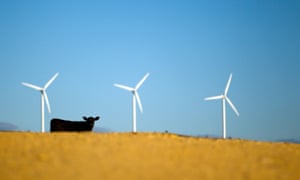For first time, state has cheaper wholesale power than rest of country for consecutive months
The shift to more than 50% clean energy in South Australia led to the lowest average wholesale power prices in the national electricity grid over the past two months, an audit has found.
According to the national energy emissions audit published by the Australia Institute, South Australia has had lower monthly wholesale electricity prices than Victoria since January, than New South Wales since August and than Queensland and Tasmania for the past two months.
It is the first time the state has had cheaper wholesale power than all other states for consecutive months. It coincided with the percentage of electricity from wind and solar energy in the state reaching nearly 65% in November.
Hugh Saddler, the author of the monthly audit and an associate
professor at the Australian National University, said wind and solar
power supplied more than 50% of the electricity generated in South
Australia for most months over the past two years. “That’s made
electricity in SA the cheapest in the national electricity market and
dramatically increased reliability.”According to the national energy emissions audit published by the Australia Institute, South Australia has had lower monthly wholesale electricity prices than Victoria since January, than New South Wales since August and than Queensland and Tasmania for the past two months.
It is the first time the state has had cheaper wholesale power than all other states for consecutive months. It coincided with the percentage of electricity from wind and solar energy in the state reaching nearly 65% in November.
Saddler said the benefits would be increased if a proposed new interconnector was built between South Australia and NSW as it would ensure NSW had access to solar power into the early evening, helping improve management of demand during peak periods.
The audit comes as different reports tell competing stories on electricity prices. The annual report of the Australian Energy Market Commission earlier this month found household prices were expected to start falling over the next few years, mostly due to decreases in wholesale costs as clean energy generation capacity, particularly from windfarms, increased.
On Sunday, the competition watchdog found Australian households had already saved $65 on their power bills over the past year, but it said electricity affordability required further attention, in part because while solar panels reduced bills for households that had them, others shouldered the cost of feed-in tariff incentive schemes.
According to the website Open NEM, 25.9% of electricity in the five eastern states has been from renewable sources over the past month. There was 100% clean generation in Tasmania, which runs on hydro power, 60% in South Australia, 25% in Victoria, 18% in NSW and 16% in Queensland.
The most recent federal government emissions projections suggest it expects Australia to reach 50% clean energy by 2030. The Coalition accused Labor of being economically reckless when it set a non-binding 50% renewable energy target over that timeframe before the election.
The Australia Institute audit supports government analysis that found Australia was not expected to meet its 2030 emissions reduction target – a 26-28% cut below 2005 levels – unless it relied on a controversial accounting measure. The measure, which involves claiming credit for beating previous targets under the expiring Kyoto protocol, was strongly opposed by several countries at the recent UN climate talks in Madrid.
Saddler found a brief fall in diesel fuel sales had been reversed, suggesting emissions from transport would continue to rise while there was no credible policies to reduce them.
He found an ongoing reduction in emissions from electricity generation – due to the rise of clean energy – was likely to be completely offset by rising pollution from transport, mining and agriculture.
The audit compares emissions over the five years before the repeal of the former carbon price scheme with the five years since it was abolished. While recent changes to government emissions data now suggest pollution has been lower under the Coalition than under Labor, the report found that if emissions from the land were excluded from national accounts and the focus was solely on fossil fuel industries, pollution trended down between 2009 and 2014 and had trended upwards since.
“The emissions reduction fund, which commenced in 2014, has certainly done much less to reduce emissions than the carbon price did … It is, in fact, hard to see that it has had any significant impact,” the audit report says.
“The government’s most recent projections of emissions over the next 10 years indicate very little further reduction. If Australia is to meet its Paris agreement target without using Kyoto carryover credits (for which there is no legal basis), another 13% emissions reduction will be required.”

No comments:
Post a Comment